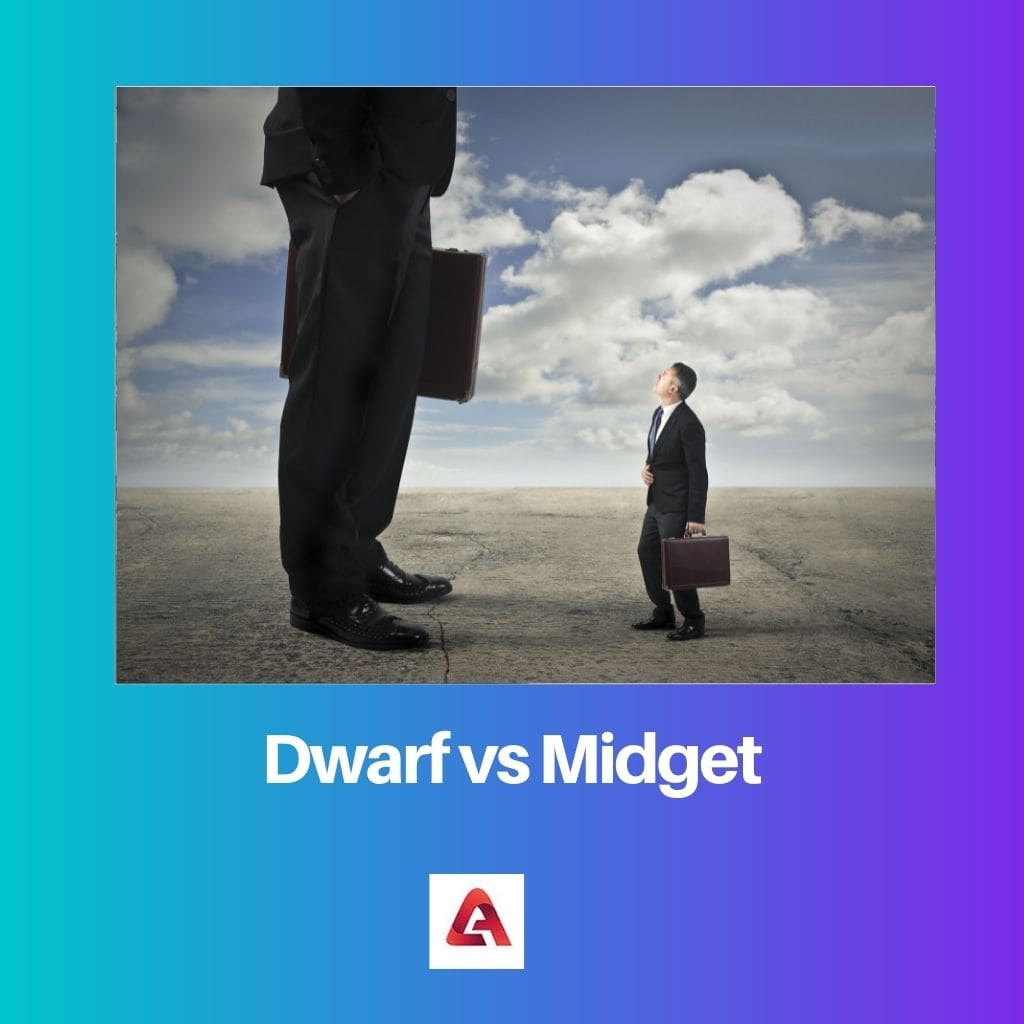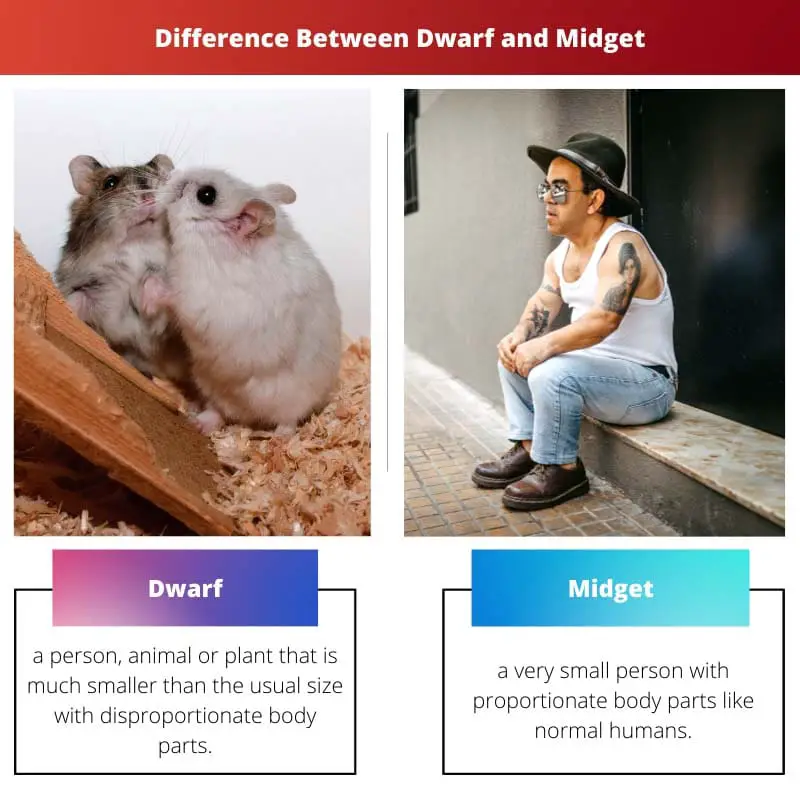As time passes, we humans continue evolving, we are adding new terms and words in our language to communicate in a better way. Sometimes we use words from ancient languages, and sometimes we modify the old words to define things easily.
Key Takeaways
- Dwarfism is a medical condition characterized by short stature due to genetic or hormonal factors, with the most common form being achondroplasia.
- The term “midget” was historically used to describe individuals of short stature without the typical physical characteristics of dwarfism but is now considered offensive and derogatory.
- To show respect and sensitivity, use “little person” or “person with dwarfism” instead of outdated or offensive terminology.
Difference Between Dwarf and Midget
Just like that, the word “Dwarf” derived from the ancient German language. The dwarf is used for a concise person, someone less than 58 inches tall.
Midget comes from the word “myth” used for the small fly. Both Dwarf and Midget describe a short person. however, midget is considered an offensive word nowadays.
If a person has an adult height of 147 cm (4 ft 10 in), then he/she is considered a dwarf. Medically when a person has a condition that causes them to be very short with the disproportion of body parts is known as dwarfism.

Midget can also be used for a concise person but is normally proportioned. But nowadays, this word is rarely used and is also considered offensive. It’s been utilized until the finish of the twentieth century.
Comparison Table for Dwarf vs Midget
| Parameter of comparison | Dwarf | Midget |
|---|---|---|
| Definition | a person, animal or plant that is much smaller than the usual size with disproportionate body parts | a very small person with proportionate body parts like normal humans |
| Offensive | Not considered offensive | Considered offensive |
| Affects | Humans, animals, and plants | Humans only |
| Height | 147 cm (4 ft 10 in) | 147 cm (4 ft 10 in) |
| Physical condition | Extremely short but disproportionate body type – joint diseases, enlarged head, bow legs, dental problems, hunched back. | Concise but proportionate body type |
| Causes | Genetic disorder | Genetic disorder |
What is Dwarf?
The word dwarf is used for a person with a very short height (147cm) in their adulthood and has a body disproportionate medically; this is called dwarfism.
The primary cause of dwarfism is hereditary clutters, and dwarfism can likewise be because of metabolic issues or malnourishment. Dwarfism is not a disease, and therefore it has no medical definition.
A person with dwarfism can have these problems – an enlarged head, bow legs, dental problems, hunched back, physical deformity or scoliosis.
The most realized dwarfism is skeletal dysplasia. Skeletal dysplasias are states of strange bone development that, because of lopsided dwarfism, can prompt other medical issues, for example, osteoarthritis.
Dwarfs also can have proportionate body types, and most dwarfs can do all things that a normal human can do.
Proportionate dwarfism: A body is proportionately little if all body pieces are little to a similar degree and seem, by all accounts, to be proportioned like an assemblage of normal stature.
Ailments present during childbirth or showing up in youth limit, by and large, development and improvement.
Just like humans’ dwarfs can be found in animals and plants.
A baby has more chances to be a dwarf when both parents are dwarfs (very small body stature with disproportionate body parts). However, a baby can also be a dwarf when both parents are normal in this type of case.
Causes of Dwarfism
Genetic Mutations
- Genetic mutations play a significant role in causing dwarfism. These mutations can occur in different genes that regulate bone growth and development. The most common type of dwarfism caused by genetic mutations is called achondroplasia. Achondroplasia is an autosomal dominant disorder, which means it only requires a single copy of the mutated gene from one parent to inherit the condition. This mutation affects the conversion of cartilage to bone during growth, resulting in shorter limbs and overall stature.
Other genetic conditions that can cause dwarfism include:
- Spondyloepiphyseal dysplasia: This condition affects the bones of the spine and the ends of long bones, leading to a shorter trunk and limbs.
- Diastrophic dysplasia: This rare genetic disorder affects cartilage and bone development, causing skeletal abnormalities and short stature.
- Pseudoachondroplasia: It is a condition similar to achondroplasia but with milder symptoms. It also affects cartilage and bone development, resulting in short limbs and stature.
Hormonal Imbalances
Hormonal imbalances can also contribute to dwarfism. Growth hormone (GH) is essential for normal growth and development in children. If the body does not produce enough GH or if there are abnormalities in the receptors that respond to GH, it can lead to a condition called growth hormone deficiency (GHD). Children with GHD may have slower growth rates and fail to reach their expected height.
Diagnosis
Prenatal Diagnosis
Prenatal diagnosis refers to identifying dwarfism or potential risk factors for dwarfism before birth. It involves genetic testing, imaging techniques, and family history assessment. Prenatal diagnosis can help parents and healthcare providers prepare for the potential challenges of dwarfism and plan appropriate medical care.
During prenatal screening, the following methods may be employed:
- Ultrasound: An ultrasound examination during pregnancy can provide valuable information about the size and proportions of the fetus. Certain skeletal abnormalities, such as shortened limbs or other bone deformities, may be detected through ultrasound.
- Amniocentesis: In some cases, amniocentesis may be performed to obtain a sample of amniotic fluid. This fluid contains fetal cells that can be analyzed for genetic abnormalities, including specific gene mutations associated with dwarfism.
- Chorionic Villus Sampling (CVS): CVS involves obtaining a small tissue sample from the placenta. This tissue contains genetic material that can be examined for chromosomal abnormalities or specific gene mutations related to dwarfism.
Postnatal Diagnosis
Postnatal diagnosis involves assessing an individual’s physical characteristics, growth patterns, and medical history after birth. It aims to determine the cause of dwarfism and provide appropriate medical management and support. The following methods are commonly used for postnatal diagnosis:
- Physical Examination: A thorough physical examination assesses the individual’s height, limb proportions, facial features, and other characteristic signs of dwarfism. Measurements such as arm span, leg length, and head circumference may be compared to standardized growth charts.
- Medical History: A detailed medical history helps identify any underlying genetic or hormonal conditions contributing to dwarfism. Information about family history, developmental milestones, and any associated health issues is important in determining the cause of the individual’s short stature.
- Genetic Testing: Genetic testing may be performed to identify specific gene mutations associated with dwarfism. This can involve blood tests or saliva samples to analyze the individual’s DNA and detect abnormalities.
- Hormone Testing: In cases where hormonal imbalances are suspected, hormone testing, such as measuring growth hormone levels or thyroid function, may be conducted to assess the individual’s endocrine system.
Treatment
Growth Hormone Therapy
Growth hormone therapy is a common treatment option for children with growth hormone deficiency (GHD) or other hormone-related causes of dwarfism. Synthetic growth hormone is administered through regular injections to stimulate growth and improve stature. This therapy is started in childhood and may continue until the child reaches their final adult height. Growth hormone therapy can help increase growth velocity, promote bone growth, and improve body composition.
It’s important to note that growth hormone therapy is not effective for all types of dwarfism. It is primarily beneficial for individuals with GHD or those with normal or near-normal growth hormone levels but are not responding adequately to it. The decision to undergo growth hormone therapy should be made in consultation with a healthcare professional specializing in endocrinology.
Surgery
Surgical interventions may be considered for certain types of dwarfism to address specific skeletal abnormalities and improve functionality. The specific procedures will depend on the individual’s condition and needs. Some common surgical interventions for dwarfism include:
- Limb Lengthening: In limb lengthening surgery, the bones in the limbs are carefully cut and gradually lengthened using external fixation devices or internal rods. This process allows for the gradual stretching and growth of the bones over some time.
- Spinal Surgery: Some forms of dwarfism, such as those associated with spinal abnormalities, may require surgical correction. Spinal fusion or other procedures can help alleviate discomfort, improve spinal alignment, and maintain or improve mobility.
Assistive Devices
Assistive devices can greatly enhance the mobility, independence, and overall quality of life for individuals with dwarfism. These devices are designed to accommodate the unique needs of individuals with shorter stature and may include:
- Orthopedic Aids: Devices such as braces, orthotics, and custom footwear can help support and stabilize joints, improve mobility, and minimize discomfort.
- Adaptive Furniture and Equipment: Customized furniture, ergonomic workstations, and specially designed tools and equipment can facilitate accessibility and ensure comfort in various settings, including home, school, and the workplace.
- Mobility Aids: Devices such as canes, crutches, walkers, and wheelchairs can assist with mobility and enable individuals to move around more easily.

What is Midget?
Midget means a very small person with an adult height of 58 inches or 147 cm (4 ft 10 in) this word is only used for humans, not for plants or animals.
The assemblage of the midget is proportionately little, it implies all the pieces of the body are little to a similar degree and has all the earmarks of being proportioned like a group of average stature.
Just like Dwarf, Genetic disorders also cause midgets, and there are more chances of inheriting the condition when both parents are extremely short of body stature.
Midget is not a medical term, and nowadays, this word is rarely used; it’s been utilized until the finish of the twentieth century.
But now it’s considered an offensive word, so it’s better not to use this word if you want a good conversation with a short-heightened person.
There have been developments to evacuate the utilization of midget from age order classifications in youth sports.
A midget can add more inches to his or her height by taking some hormonal supplements and proper nutrition, one should keep in mind to consult with their doctor before taking any hormonal supplement.
Some people also use accessories like heightened shoes which have long heels in this way, short people can feel like normal humans, not physically, but this type of thing helps them to be confident.
Social and Cultural Implications of Midget
Midgets in Entertainment
People of short stature have been historically portrayed in entertainment industries, sometimes perpetuating stereotypes and misconceptions. However, there has been a growing awareness and advocacy for more respectful and accurate representation of individuals with dwarfism in the media. Prominent actors and performers with dwarfism, such as Peter Dinklage, have achieved significant recognition and have helped challenge preconceived notions about dwarfism.
Midgets in Sports
In recent years, there has been an increased recognition of the athletic abilities of individuals with dwarfism. Sports such as dwarf basketball, soccer, and track and field provide opportunities for athletes with dwarfism to showcase their skills and compete at various levels. Organizations like the Dwarf Athletic Association of America (DAAA) support the development of sports programs specifically designed for people of short stature.
Midgets in Society
People of short stature face unique societal challenges, including accessibility, discrimination, and misconceptions. Organizations and advocacy groups, such as the Little People of America (LPA), work to address these challenges by promoting inclusivity, raising awareness, and providing support networks for individuals with dwarfism and their families.

Main Differences Between Dwarf and Midget
- The dwarf can be found in humans, animals or plants, but midget is a term used for humans only.
- Dwarf describes a small person who has disproportionate body parts; on the other hand, Midget refers to a person who is extremely small but has proportionate body parts. Be that as it may, now and then, in our general public, an individual may be considered as a Dwarf dependent on their short stature alone.
- Dwarfism is a medical term for extremely short persons, animals or plants, but the word midget is not a medical term and is also considered offensive nowadays.
- Dwarfs are small people, just like the Midgets, but they suffer from physical problems like enlarged heads, bow legs, dental problems, hunched back physical deformity or scoliosis.
- The dwarf is derived from the German language; in old English, it was “Dweorg” with time, it turned into Dwarf, whereas Midget was first recorded in 1850-55, and it was only Midge; later, the word became Midget.



